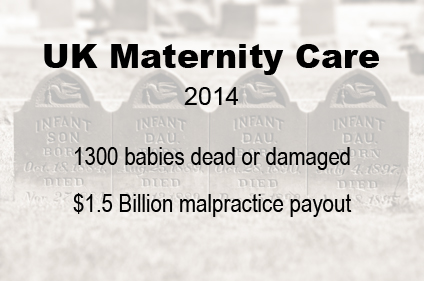Dr. Neel Shah wrote a foolish, poorly researched article on homebirth, A NICE Delivery — The Cross-Atlantic Divide over Treatment Intensity in Childbirth, and The New England Journal of Medicine published it, apparently without having it reviewed by anyone who knows anything about American homebirth. Then he penned a piece for The Conversation, Are hospitals the safest place for healthy women to have babies? An obstetrician thinks twice, that expanded and amplified his themes. That piece was syndicated in multiple outlets including Time, Newsweek and The Washington Post among others.
Dr. Shah’s NEJM commentary listed only 5 references, one of which was a piece in The New York Times. He simply ignored the existing literature on the outcomes of homebirth in the US; it appears that he didn’t even know that it existed. Dr. Shah did not appear to be aware that there is a two tier midwifery system in the US and therefore, the British study that he touted has no applicability to homebirth in the US.
Dr. Shah claimed that we should emulate the UK in promoting a greater role for out of hospital birth. He waxed rhapsodic over the Birthplace Study that purported to show that homebirth in the UK is safe for a subset of women and the purportedly superior delivery of obstetric care in the UK.
Is this the obstetric system that we ought to emulate?
From The Times of London, NHS errors leave 1,300 babies dead or maimed:
The NHS paid or set aside just under £1 billion [$1.5 billion] last year to settle 1,316 claims of negligence in maternity units, up from £488 million a decade ago, data from the NHS Litigation Authority show. The most costly claims involve babies brain-damaged during labour, who will require constant care for the rest of their lives.
One basic error accounts for a quarter of payouts, with campaigners saying it was a “scandal” that the health service was failing to learn from its mistakes. They blamed divisions between midwives and doctors, saying that the desire for “natural” births — without interventions — sometimes went too far…
To put that in perspective, last year in the US obstetric malpractice claims came to $428 million, one third the amount of the UK payout, though the US has more than 4X as many births per year and a far more litigious culture.
So on a per birth basis, the UK payout on obstetric malpractice is 1100% HIGHER than the US.
Sara Burns, a specialist in negligence at the law firm Irwin Mitchell, said that some of the rise was down to a more litigious culture, but repetition of the same type of cases pointed to fundamental problems. “There is an inherent issue with the training of midwives,” she said.
And that issue is treatment intensity. UK midwives favor low intensity treatment and that is killing babies (and mothers).
Why did Dr. Shah write a piece extolling homebirth and the UK obstetric system when the evidence shows that homebirth in the US leads to as much as an 800% increase in the perinatal death rate and the UK system is being bankrupted by payouts for dead or brain injured babies that reflect the low treatment intensity that Dr. Shah favors? Why did NEJM publish such a foolish, poorly researched piece?
In April of this year, Richard Horton, editor of the prestigious scientific journal The Lancet, issued a blistering critique of contemporary scientific journals:
The case against science is straightforward: much of the scientific literature, perhaps half, may simply be untrue. Afflicted by studies with small sample sizes, tiny effects, invalid exploratory analyses, and flagrant conflicts of interest, together with an obsession for pursuing fashionable trends of dubious importance, science has taken a turn towards darkness…
Specifically:
In their quest for telling a compelling story, scientists too often sculpt data to fit their preferred theory of the world. Or they retrofit hypotheses to fit their data. Journal editors deserve their fair share of criticism too. We aid and abet the worst behaviours. Our acquiescence to the impact factor fuels an unhealthy competition to win a place in a select few journals. Our love of “significance” pollutes the literature with many a statistical fairy-tale.
Let’s leave aside for the moment the fact that Horton, in his capacity as editor of the The Lancet, has the power to keep bad science out of his journal, but has not employed it. His critique is spot on, as Dr.Neel Shah’s recent piece on homebirth in The New England Journal of Medicine demonstrates.
Fashionable trends of dubious importance? Check!
Dr. Shah’s piece capitalized on two fashionable trends, the demonization of C-sections and an infatuation with homebirth.
Sculpting the data to fit a preferred theory of the world? Check!
Dr. Shah is looking for ways to save money on healthcare and he thinks obstetrics is the place. He started with the conclusion and didn’t even bother to check the literature to see if it supported that conclusion.
Untrue? Check!
Ignoring the existing scientific literature on US homebirth, relying on a British study that is inapplicable to the US, and apparently unaware of the deadly and extraordinarily expensive result of midwifery led low treatment intensity care, Dr. Shah crafted a fairytale … and then disseminated that fairytale far and wide. How? By relying on the fact that both scientific journals and mainstream publications are obsessed with fashionable trends of dubious importance.


